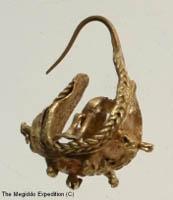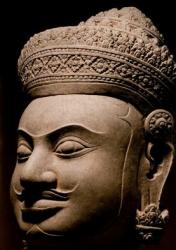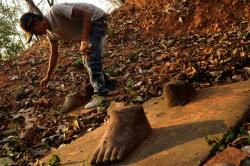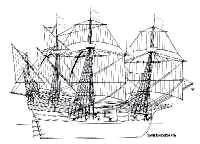INSTITUT SUPERIEUR D'ANTHROPOLOGIE
INSTITUTE OF ANTHROPOLOGY
ONLINE COURSES / COURS A DISTANCE
INSCRIPTION 2012 / Session II : Avril 2012
REGISTRATION 2012 / Term II : April 2012
ISRAEL –  – Megiddo - Archaeologists working at the site of Megiddo in Israel’s Jezreel Valley recently discovered a hoard of gold, silver and bronze jewelry dating to around 1100 B.C.E. The jewelry was found wrapped in fabric and hidden inside a ceramic vessel that had been excavated in the summer of 2010 from an early Iron Age dwelling at the site. It is hoped that further analysis of both the textiles and jewelry can reveal important clues as to their origins and use.
– Megiddo - Archaeologists working at the site of Megiddo in Israel’s Jezreel Valley recently discovered a hoard of gold, silver and bronze jewelry dating to around 1100 B.C.E. The jewelry was found wrapped in fabric and hidden inside a ceramic vessel that had been excavated in the summer of 2010 from an early Iron Age dwelling at the site. It is hoped that further analysis of both the textiles and jewelry can reveal important clues as to their origins and use.
http://www.biblicalarchaeology.org/daily/news/jewelry-from-the-time-of-the-judges-found-at-megiddo/
CAMBODGE – 
 Koh Ker - Cambodia has asked the United States government for help in recovering a thousand-year-old statue of a mythic warrior that sits in limbo at Sotheby’s in New York and that some experts believe was looted amid the convulsions of the Vietnam War and the killing fields of the Khmer Rouge. The auction house says that the seller is a “noble European lady” who acquired it in 1975. Although it was severed from its feet and pedestal, which were left behind at a remote Cambodian archaeological site, Sotheby’s says there is no proof that it was taken illegally. The discovery was made in Koh Ker, 60 miles northeast of the Angkor Wat temple complex; Koh Ker, another city in the Khmer empire, was at one time a rival capital to Angkor. The sculpture, which is five feet tall and weighs 250 pounds, is one of a pair of scowling athlete-combatants in intricate headdresses from the mid 900s who were positioned in battle-ready stances and come from one of Koh Ker’s temples; it is about 200 years older than the famous sculptures at Angkor Wat.
Koh Ker - Cambodia has asked the United States government for help in recovering a thousand-year-old statue of a mythic warrior that sits in limbo at Sotheby’s in New York and that some experts believe was looted amid the convulsions of the Vietnam War and the killing fields of the Khmer Rouge. The auction house says that the seller is a “noble European lady” who acquired it in 1975. Although it was severed from its feet and pedestal, which were left behind at a remote Cambodian archaeological site, Sotheby’s says there is no proof that it was taken illegally. The discovery was made in Koh Ker, 60 miles northeast of the Angkor Wat temple complex; Koh Ker, another city in the Khmer empire, was at one time a rival capital to Angkor. The sculpture, which is five feet tall and weighs 250 pounds, is one of a pair of scowling athlete-combatants in intricate headdresses from the mid 900s who were positioned in battle-ready stances and come from one of Koh Ker’s temples; it is about 200 years older than the famous sculptures at Angkor Wat.
http://www.nytimes.com/2012/02/29/arts/design/sothebys-caught-in-dispute-over-prized-cambodian-statue.html?pagewanted=1&_r=2&hp
ROYAUME UNI –  Flag Fen - Renowned Bronze Age archaeological site Flag Fen in Cambridgeshire will host a first-of-its-kind dig that makes the public integral to the project. Flag Fen was discovered in 1982 by archaeologist Francis Pryor, who uncovered part of a one mile (1.6km) causeway across the Fenland marshes in Cambridgeshire. The site lies largely underground, preserved for 3,000 years beneath a layer of peat that keeps artefacts from decaying. An exposed part of the site, called the preservation hall, shows some of the thousands of timbers that make up the site poking up through the ground, and these are regularly watered to stave off decay. Beneath, the peat will have preserved not just the wood artefacts such as leather and other organic material, which at other Bronze Age sites will have long since been consumed. But the water that has kept Flag Fen preserved until now is seeping away, due in part to climate change but largely to active drainage and the sprawl of neighbouring Peterborough, which nearly reaches the borders of the site.
Flag Fen - Renowned Bronze Age archaeological site Flag Fen in Cambridgeshire will host a first-of-its-kind dig that makes the public integral to the project. Flag Fen was discovered in 1982 by archaeologist Francis Pryor, who uncovered part of a one mile (1.6km) causeway across the Fenland marshes in Cambridgeshire. The site lies largely underground, preserved for 3,000 years beneath a layer of peat that keeps artefacts from decaying. An exposed part of the site, called the preservation hall, shows some of the thousands of timbers that make up the site poking up through the ground, and these are regularly watered to stave off decay. Beneath, the peat will have preserved not just the wood artefacts such as leather and other organic material, which at other Bronze Age sites will have long since been consumed. But the water that has kept Flag Fen preserved until now is seeping away, due in part to climate change but largely to active drainage and the sprawl of neighbouring Peterborough, which nearly reaches the borders of the site.
http://www.bbc.co.uk/news/science-environment-17211285
FRANCE –  Brest - Le 10 août 1512 la Cordelière, nef d’Anne de Bretagne, affronte en un combat singulier le Regent, navire amiral de la flotte d’Henri VIII d’Angleterre. Leurs capitaines respectifs Hervé de Portzmoguer et Eward Howard se vouent une haine personnelle farouche, aucun d’eux n’acceptant de lâcher prise. À l’occasion du 500ème anniversaire de ce combat naval inscrit dans la mémoire collective de la Bretagne, Max Guérout, archéologue naval, explique également les mois passés à chercher en vain les épaves des deux navires à l’entrée du goulet de Brest.
Brest - Le 10 août 1512 la Cordelière, nef d’Anne de Bretagne, affronte en un combat singulier le Regent, navire amiral de la flotte d’Henri VIII d’Angleterre. Leurs capitaines respectifs Hervé de Portzmoguer et Eward Howard se vouent une haine personnelle farouche, aucun d’eux n’acceptant de lâcher prise. À l’occasion du 500ème anniversaire de ce combat naval inscrit dans la mémoire collective de la Bretagne, Max Guérout, archéologue naval, explique également les mois passés à chercher en vain les épaves des deux navires à l’entrée du goulet de Brest.
http://www.voilesnews.fr/fr/info_21_31565.html
PAKISTAN – Kafiristan - A one-day workshop on the dossier preparation for inscription of the Kalash Valley culture on the World Heritage List was organised at Lok Virsa . The discussions revolved around certain measures to be taken for safeguarding Kalash cultural heritage including devising an inventory of endangered elements of tangible and intangible culture; efforts for documentation of Kalash culture; preserving Kalash culture in the villages of Bamborate, Birir and Rambur; safeguarding the language; preserving the music of Kalash in its original form; and protecting Kalash nomenclature currently under threat. The word Kalash bears three meanings: name of the tribe, name of a pagan religion and it is also the name of an endangered language. The present Kalash community is restricted to three parallel valleys of Chitral district ie Bomboret, Birir and Rambur called the Kalash valleys or Kafiristan. Historically, Kalash were majority population in Chitral and ruled it in the 12th century. In 1320, Muslim invader Rais conquered Chitral, and forcibly converted the Kalash community. After embracing Islam the Kalash community abandoned their religion as well as their language and ethnic identity, except a few thousand people who took refuge in three confined valleys of Bamboret, Birir and Rambur.
http://tribune.com.pk/story/343670/culture-preservation-experts-scholars-for-preservation-of-kalash-culture/